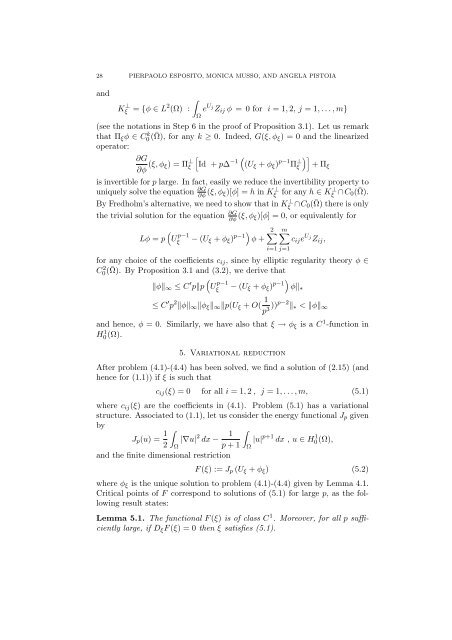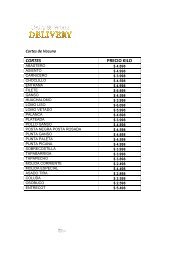CONCENTRATING SOLUTIONS FOR A PLANAR ... - CAPDE
CONCENTRATING SOLUTIONS FOR A PLANAR ... - CAPDE
CONCENTRATING SOLUTIONS FOR A PLANAR ... - CAPDE
Create successful ePaper yourself
Turn your PDF publications into a flip-book with our unique Google optimized e-Paper software.
28 PIERPAOLO ESPOSITO, MONICA MUSSO, AND ANGELA PISTOIA<br />
and<br />
∫<br />
Kξ ⊥ = {φ ∈ L 2 (Ω) :<br />
Ω<br />
e U j<br />
Z ij φ = 0 for i = 1, 2, j = 1, . . . , m}<br />
(see the notations in Step 6 in the proof of Proposition 3.1). Let us remark<br />
that Π ξ φ ∈ C0 k(¯Ω), for any k ≥ 0. Indeed, G(ξ, φ ξ ) = 0 and the linearized<br />
operator:<br />
∂G<br />
∂φ (ξ, φ ξ) = Π ⊥ ξ<br />
[<br />
( )]<br />
Id + p∆ −1 (U ξ + φ ξ ) p−1 Π ⊥ ξ + Π ξ<br />
is invertible for p large. In fact, easily we reduce the invertibility property to<br />
uniquely solve the equation ∂G<br />
∂φ (ξ, φ ξ)[φ] = h in Kξ<br />
⊥ for any h ∈ K⊥ ξ ∩C 0(¯Ω).<br />
By Fredholm’s alternative, we need to show that in Kξ ⊥ ∩C 0(¯Ω) there is only<br />
the trivial solution for the equation ∂G<br />
∂φ (ξ, φ ξ)[φ] = 0, or equivalently for<br />
(<br />
Lφ = p U p−1<br />
ξ<br />
− (U ξ + φ ξ ) p−1) 2∑ m∑<br />
φ + c ij e U j<br />
Z ij ,<br />
i=1 j=1<br />
for any choice of the coefficients c ij , since by elliptic regularity theory φ ∈<br />
C0 2(¯Ω). By Proposition 3.1 and (3.2), we derive that<br />
(<br />
‖φ‖ ∞ ≤ C ′ p‖p U p−1<br />
ξ<br />
− (U ξ + φ ξ ) p−1) φ‖ ∗<br />
≤ C ′ p 2 ‖φ‖ ∞ ‖φ ξ ‖ ∞ ‖p(U ξ + O( 1 p 3 ))p−2 ‖ ∗ < ‖φ‖ ∞<br />
and hence, φ = 0. Similarly, we have also that ξ → φ ξ is a C 1 -function in<br />
H 1 0 (Ω).<br />
5. Variational reduction<br />
After problem (4.1)-(4.4) has been solved, we find a solution of (2.15) (and<br />
hence for (1.1)) if ξ is such that<br />
c ij (ξ) = 0 for all i = 1, 2 , j = 1, . . . , m, (5.1)<br />
where c ij (ξ) are the coefficients in (4.1). Problem (5.1) has a variational<br />
structure. Associated to (1.1), let us consider the energy functional J p given<br />
by<br />
J p (u) = 1 ∫<br />
|∇u| 2 dx − 1 ∫<br />
|u| p+1 dx , u ∈ H0 1 (Ω),<br />
2 Ω<br />
p + 1 Ω<br />
and the finite dimensional restriction<br />
F (ξ) := J p (U ξ + φ ξ ) (5.2)<br />
where φ ξ is the unique solution to problem (4.1)-(4.4) given by Lemma 4.1.<br />
Critical points of F correspond to solutions of (5.1) for large p, as the following<br />
result states:<br />
Lemma 5.1. The functional F (ξ) is of class C 1 . Moreover, for all p sufficiently<br />
large, if D ξ F (ξ) = 0 then ξ satisfies (5.1).





